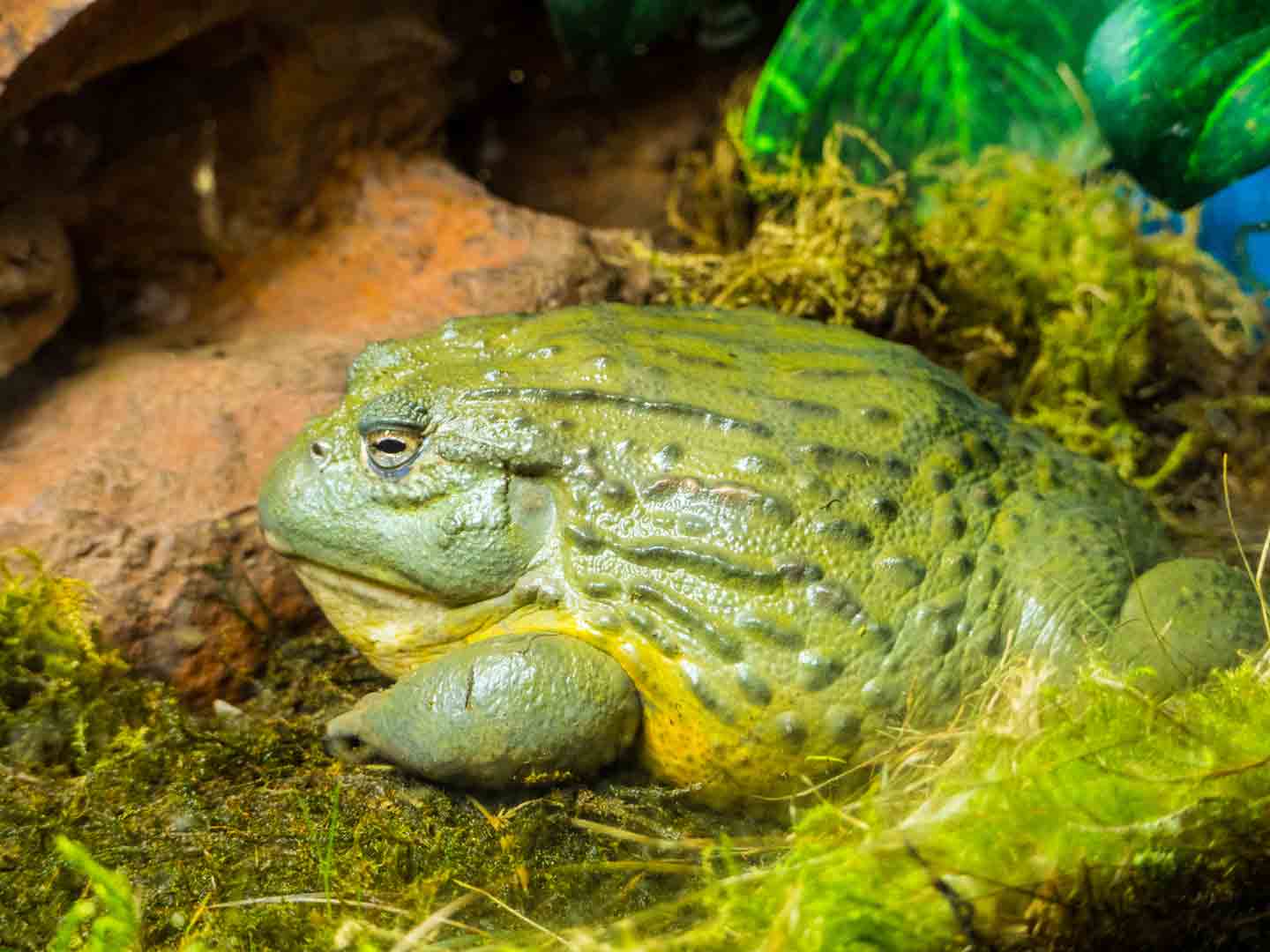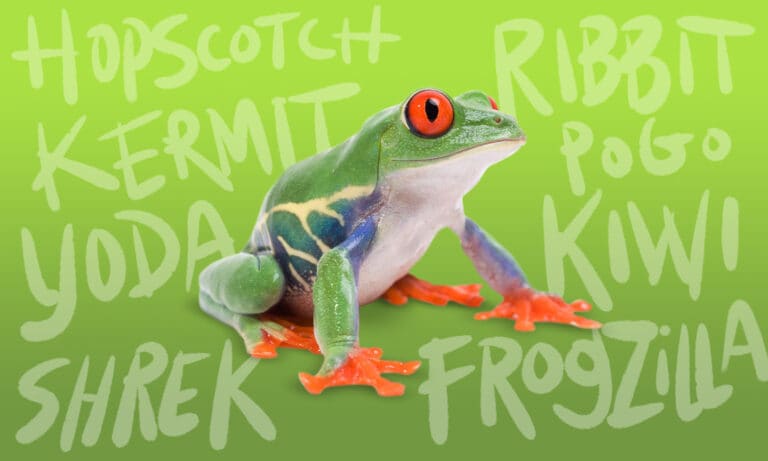7 Best Pet Frogs

1White’s Tree Frog
- Scientific name: Litoria caerulea
- Average size: 3-5 inches
- Average life expectancy: 16 years
One of the most widely captive-bred frog species, White’s tree frogs are a good choice for beginners. They’re also known as Australian green tree frogs or dumpy tree frogs, and are popular for their small size and adaptability. White’s tree frogs are green or blue-green in color with a waxy coating on their skin, which enables them to tolerate lower levels of humidity than many tree frogs. They’re very docile by nature and can sometimes be tamed enough for handling.

2Pacman Frog (Argentine Horned Frog)
- Scientific name: Ceratophrys ornata
- Average size: 4-7 inches
- Average life expectancy: 4-6 years
Another terrestrial frog species, Argentine horned frogs are nicknamed Pacman frogs after the arcade game character known for its large mouth. They have a round body and come in an array of attractive color morphs like strawberry or chocolate-mint. Because they’re a relatively sedentary species, Pacman frogs don’t require very large enclosures despite their size. Pacman frogs are predatory amphibians, however, and have been known to bite anything that looks like prey. They may not be appropriate for handling.

3African Bullfrog (Pixie Frog)
- Scientific name: Pyxicephalus adspersus
- Average size: 4-10 inches
- Average life expectancy: Up to 40 years
Even larger than the Pacman frog, the African bullfrog goes by a deceiving nickname—pixie frog. These frogs are green in color with a yellow, orange, or beige belly. Adult pixie frogs require at least a 30-gallon tank with areas of both dry land and fresh water. Because they like to burrow, these frogs should be given a container of dirt inside their enclosure as well. Some pixie frogs tolerate handling but may bite when stressed. They’re one of the frog species with toothlike structures, so African bullfrogs may not be appropriate for children.

4Gray Tree Frog
- Scientific name: Dryophytes versicolor / Hyla versicolor
- Average size: 1-2 inches
- Average life expectancy: 7-9 years
Native to the United States and Canada, the gray tree frog is a small, arboreal (tree) frog species. They can change color in response to their environment, ranging from gray to green to brown with blotchy patches that look like lichen. Unlike tropical tree frogs, the gray tree frog doesn’t require high temperatures or humidity levels. This species is best kept in a glass terrarium with moist substrate and plenty of things to climb. These frogs can also benefit from UVB lighting to help them synthesize vitamin D3 and absorb calcium.

5American Green Tree Frog
- Scientific name: Hyla cinerea
- Average size: 1-2.5 inches
- Average life expectancy: up to 6 years
Named for their bright green color, these tree frogs are native to the southeastern United States. American green tree frogs stay fairly small and are generally easy to care for. They’re not picky about temperature, as long as their habitat doesn’t drop below 70 degrees Fahrenheit. A misting system or fogger is required, however, to maintain proper humidity levels. Though docile by nature, this species is timid and their delicate skin can be damaged by rough or frequent handling.

6Tomato Frog
- Scientific name: Dyscophus antongilii, D. insularis or D. guineti
- Average size: 2.5-4 inches
- Average life expectancy: 6 years
The name tomato frog applies to three different species of frogs in the genus Dyscophus. Typically bright red in color, tomato frogs are known to inflate themselves when they feel threatened, which makes it difficult for predators to swallow them. Though they aren’t aquatic frogs, tomato frogs need a water bowl in their terrarium as well as substrate deep enough to burrow in. Tomato frogs spend much of their time burrowed and don’t like being handled.

7African Dwarf Frog/Zaire Dwarf Clawed Frog
- Scientific name: Hymenochirus boettgeri
- Average size: 1-1.5 inches
- Average life expectancy: 5 years
Native to Africa, this small, aquatic frog species is typically brown or slightly green in color with dark spots. African dwarf frogs have similar care requirements to the typical tropical freshwater aquarium. They’re small, active, and relatively easy to care for, but should not be handled. Feeding may be a challenge, however, as many will not accept flaked food or pellets. Rather, African dwarf frogs require a diet of live, frozen, or freeze-dried foods like bloodworms, tubifex worms, and brine shrimp.
Frogs To Avoid as Pets
Teresa Manucy, DVM, a telehealth veterinarian at Chewy, in Jacksonville, Florida, says, “Frogs that are caught in the wild should not be kept as pets.” She also cautions inexperienced frog owners from keeping “any species that needs an advanced setup with complicated maintenance to thrive,” such as poison dart frogs and Vietnamese mossy frogs.
Frog species that require a large habitat or specialized care and may not be appropriate for beginners include:
- Poison dart frogs (Dendrobates sp.)
- Vietnamese mossy frogs (Theloderma corticale)
- Red-eyed tree frogs (Agalychnis callidryas)
- Amazon milk frogs (Trachycephalus resinifictrix)
- American bullfrogs (Lithobates catesbeianus)
- Fire-bellied toads (Bombina sp.)
It’s also important to obey local laws that restrict ownership of certain species. For example, the African clawed frog (Xenopus laevis) is considered an invasive species and is illegal to own without a permit in more than 10 U.S. states.
Caring for Frogs
Before you decide whether a frog is right for you, familiarize yourself with the basics of frog care.
Diet
Dietary requirements vary depending on the type of frog and its natural environment, but most amphibians eat invertebrates like insects, insect larvae, and snails. Large frogs may also eat small vertebrates, and aquatic frogs may eat fish. All frogs should have fresh water available.
In captivity, most frogs can be fed a variety of live or freeze-dried insects such as:
- Caterpillars
- Crickets
- Earthworms
- Fruit flies
- Mealworms
- Roaches
- Waxworms
Some pet frogs will eat commercial frog pellets but many won’t, so variety is the key to a balanced diet. Live food should be gut-loaded (raised and fed) with nutritious fruits and vegetables, and some frogs may benefit from powdered calcium or multivitamin supplements.
Habitat
An ideal pet frog habitat mimics the conditions found in that species’ native environment. Terrestrial frogs can generally be kept in glass terrariums or screen enclosures, while aquatic frogs require an aquarium.
Depending on individual species requirements, you may need to provide a heat source, equipment to measure and maintain humidity, and a source of UVB lighting. All frogs require access to clean water; some will need a water dish as well, while aquatic frogs will just need a tank with clean water.
Other elements you may need for your frog habitat could include artificial or live plants for decoration and climbing, places for your frog to hide, and bedding to help maintain humidity. Make sure your frog habitat also has a lid that locks securely to prevent escape.
Handling
Dr. Manucy says, “Frog handling should be kept to a minimum due to their delicate slime layer and fragile skin.” In addition to the risk of accidentally hurting your frog, handling can be a stressful experience for them.
“The smaller the frog, the less it can tolerate handling,” says Dr. Manucy. If you do choose to pet or handle your frog, wash your hands before and after. Before handing, wash your hands with fragrance-free soap and leave your hands damp to help keep your frog’s skin from drying out. After handling, wash with antibacterial soap to prevent the spread of pathogens like salmonella.
When To See a Vet
A healthy frog has clear eyes, moist skin, and a strong appetite. If your frog fails to display natural behaviors like hunting for food or exploring their habitat, they could be sick. If you notice the following signs of poor frog health, seek veterinary care:
- Lethargy
- Weight loss
- Changes in appetite, appearance, or behavior
Most veterinarians have limited training for exotic pets like frogs, so it’s important to find a qualified vet in your area before you need one. Take your new frog in for an initial exam when you first get them, to set a baseline for future visits.
FAQs About Pet Frogs
Q:What are the friendliest pet frogs?
A:Frog species like gray tree frogs and White’s tree frogs are often mild-mannered and beginner-friendly.
Q:Do pet frogs like to be held?
A:While some species will tolerate occasional handling, most frogs do not like to be held. Some species are prone to biting, and others secrete substances that can be harmful to humans.
Q:Are frogs low-maintenance pets?
A:It depends on the type of frog you choose. Dr. Manucy says, “Caring for frogs requires a continual balance of providing specific diet and environmental needs in an indoor environment.” Some species have simple requirements while others require more equipment and experience to keep properly.
Having learned which frog species make good pets, you’re now ready to decide which one is right for you. From there, it’s time to dig into the details of frog care. Learn more about caring for pet frogs.
Expert input was provided by Teresa Manucy, DVM, a telehealth veterinarian at Chewy, in Jacksonville, Florida.
This content was medically reviewed by Chewy vets.
More About Frogs
Share:













